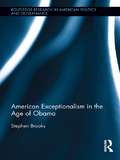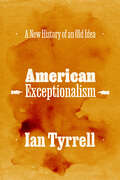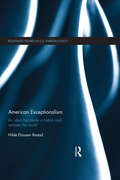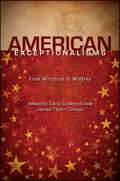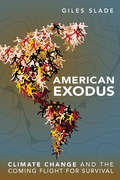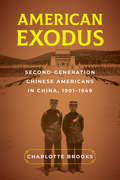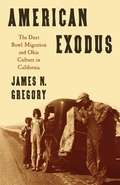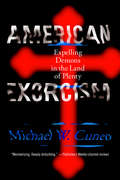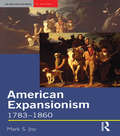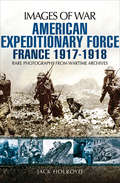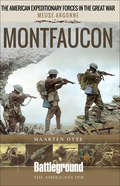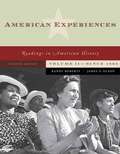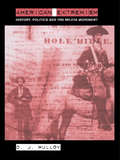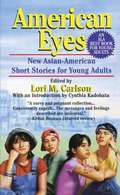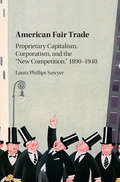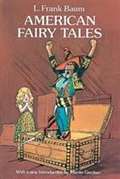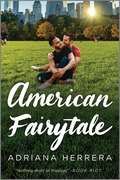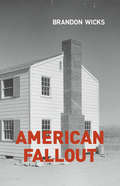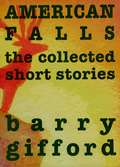- Table View
- List View
American Exceptionalism in the Age of Obama (Routledge Research in American Politics and Governance)
by Stephen BrooksThe election of President Obama in 2008 and the apparent decline of American power in the world has rekindled an old and important debate. Is the United States exceptional in its values and institutions, as well as in the role that it is destined to play in world affairs? In this book, Stephen Brooks argues that American exceptionalism has been and continues to be real. In making this argument he focuses on five aspects of American politics and society that are most crucial to an understanding of American exceptionalism today. They include the appropriate relationship between the state and citizens, religion, socio-economic mobility, America’s role in the world, and ideas about the Constitution. American exceptionalism matters in domestic politics chiefly as a political narrative around which support for and opposition to certain policies, values and vision of American society coalesce. But in world affairs it is not the story but the empirical reality of American exceptionalism that matters. Although the long era of America’s global economic dominance has entered what might be called a period of diminished expectations, the United States remains exceptional—the indispensable nation—in world affairs and is likely to remain so for many years to come.
American Exceptionalism: A New History of an Old Idea
by Ian TyrrellA powerful dissection of a core American myth. The idea that the United States is unlike every other country in world history is a surprisingly resilient one. Throughout his distinguished career, Ian Tyrrell has been one of the most influential historians of the idea of American exceptionalism, but he has never written a book focused solely on it until now. The notion that American identity might be exceptional emerged, Tyrrell shows, from the belief that the nascent early republic was not simply a postcolonial state but a genuinely new experiment in an imperialist world dominated by Britain. Prior to the Civil War, American exceptionalism fostered declarations of cultural, economic, and spatial independence. As the country grew in population and size, becoming a major player in the global order, its exceptionalist beliefs came more and more into focus—and into question. Over time, a political divide emerged: those who believed that America’s exceptionalism was the basis of its virtue and those who saw America as either a long way from perfect or actually fully unexceptional, and thus subject to universal demands for justice. Tyrrell masterfully articulates the many forces that made American exceptionalism such a divisive and definitional concept. Today, he notes, the demands that people acknowledge America’s exceptionalism have grown ever more strident, even as the material and moral evidence for that exceptionalism—to the extent that there ever was any—has withered away.
American Exceptionalism: An Idea that Made a Nation and Remade the World (Routledge Studies in US Foreign Policy)
by Hilde Eliassen RestadHow does American exceptionalism shape American foreign policy? Conventional wisdom states that American exceptionalism comes in two variations – the exemplary version and the missionary version. Being exceptional, experts in U.S. foreign policy argue, means that you either withdraw from the world like an isolated but inspiring "city upon a hill," or that you are called upon to actively lead the rest of the world to a better future. In her book, Hilde Eliassen Restad challenges this assumption, arguing that U.S. history has displayed a remarkably constant foreign policy tradition, which she labels unilateral internationalism. The United States, Restad argues, has not vacillated between an "exemplary" and a "missionary" identity. Instead, the United States developed an exceptionalist identity that, while idealizing the United States as an exemplary "city upon a hill," more often than not errs on the side of the missionary crusade in its foreign policy. Utilizing the latest historiography in the study of U.S. foreign relations, the book updates political science scholarship and sheds new light on the role American exceptionalism has played – and continues to play – in shaping America’s role in the world. This work will be of great interest to students and scholars of US foreign policy, security studies, and American politics.
American Exceptionalism: Economics, Finance, Political Economy, and Economic Laws
by Michael Szenberg Lall RamrattanThe publication of Alexis de Tocqueville’s Democracy in America has kindled interest across disciplines to appraise the exceptional nature of U.S. activities. In general, however, all the published works have not focused their analyses from an economic point of view. While economics was for some a “dismal science” following Thomas Carlyle’s characterization of Malthus’ demographic model, it has increasingly become the “queen of the social sciences” for more practitioners. The book fills a gap in the literature by describing the American contributors as precursors and genuinely exceptional economists. We present their works within the state of the nation in which they advance their discipline.One is treated to both qualitative and quantitative theories in the opening chapter. Budding theories that became established theories of Economics and Finance are investigated in Chapters II and III. When President John Adams was confronted with M. Turgot’s criticisms of the American government, he resorted to a historic survey of types of government from ancient Greece to the Middle Ages. Similarly, we have included a final chapter, Chapter IV, to present the argument for American Exceptionalism in the domain of Political Economy and Economic Law over the ages.
American Exceptionalisms: From Winthrop to Winfrey
by James Taylor Carson Sylvia SöderlindAn incisive and wide ranging look at a powerful force and myth in American culture and history, American Exceptionalisms reveals the centuries-old persistence of the notion that the United States is an exceptional nation, in being both an example to the world and exempt from the rules of international law. Scholars from North America and Europe trace versions of the rhetoric of exceptionalism through a multitude of historical, cultural, and political phenomena, from John Winthrop's vision of the "cittie on a hill" and the Salem witch trials in the seventeenth century to The Blair Witch Project and Oprah Winfrey's "Child Predator Watch List" in the twenty-first century. The first set of essays focus on constitutive historical moments in the development of the myth, rom early exploration narratives through political debates in the early republic to twentieth-century immigration debates. The latter essays address the role of exceptionalism in the "war on terror" and such cornerstones of modern popular culture such as the horror stories of H.P. Lovecraft, the songs of Steve Earle, and the Oprah Winfrey show.Sylvia Söderlind is Associate Professor of English Language and Literature at Queen's University, Kingston, Ontario, Canada. She is the author of Margin/Alias: Language and Colonization in Canadian and Québécois Fiction (Toronto: University of Toronto Press, 1991) and articles on American, Canadian and Québécois fiction, "ghostmodernism" and translation, and the politics of metaphor published in, among others, Canadian Review of Comparative Literature, Ariel, Essays in Canadian Writing, Voix et images, RS/SI, New Feminism Review (Japan), ARTES (Sweden).James Taylor Carson is Professor of History and Associate Dean in the Faculty of Arts and Science at Queen's University, Kingston, Ontario, Canada. His scholarship focuses on the ethnohistory of native peoples in the American South, and he has published two books on the subject, Searching for the Bright Path: The Mississippi Choctaws from Prehistory to Removal (Lincoln: University of Nebraska Press, 1999) and Making an Atlantic World: Circles, Paths, and Stories from the Colonial South (Knoxville: University of Tennessee Press, 2007).
American Exodus
by Giles SladeAs temperatures rise, declines in agricultural production and freshwater supply will diminish US carrying capacity by 2/3, and rising sea levels will impact the country's most densely populated regions. A frightening survey of what's to come, American Exodus argues that mankind can survive the coming century of climate chaos if we act quickly to preserve our shelter of last resort.
American Exodus: Second-Generation Chinese Americans in China, 1901–1949
by Charlotte BrooksIn the first decades of the 20th century, almost half of the Chinese Americans born in the United States moved to China—a relocation they assumed would be permanent. At a time when people from around the world flocked to the United States, this little-noticed emigration belied America’s image as a magnet for immigrants and a land of upward mobility for all. Fleeing racism, Chinese Americans who sought greater opportunities saw China, a tottering empire and then a struggling republic, as their promised land. American Exodus is the first book to explore this extraordinary migration of Chinese Americans. Their exodus shaped Sino-American relations, the development of key economic sectors in China, the character of social life in its coastal cities, debates about the meaning of culture and “modernity” there, and the U.S. government’s approach to citizenship and expatriation in the interwar years. Spanning multiple fields, exploring numerous cities, and crisscrossing the Pacific Ocean, this book will appeal to anyone interested in Chinese history, international relations, immigration history, and Asian American studies.
American Exodus: The Dust Bowl Migration And Okie Culture In California
by James N. GregoryFifty years ago, John Steinbeck's now classic novel, The Grapes of Wrath, captured the epic story of an Oklahoma farm family driven west to California by dust storms, drought, and economic hardship. It was a story that generations of Americans have also come to know through Dorothea Lange's unforgettable photos of migrant families struggling to make a living in Depression-torn California. Now in James N. Gregory's pathbreaking American Exodus, there is at last an historical study that moves beyond the fiction and the photographs to uncover the full meaning of these events. American Exodus takes us back to the Dust Bowl migration of the 1930s and the war boom influx of the 1940s to explore the experiences of the more than one million Oklahomans, Arkansans, Texans, and Missourians who sought opportunities in California. Gregory reaches into the migrants' lives to reveal not only their economic trials but also their impact on California's culture and society. He tracesthe development of an "Okie subculture" that over the years has grown into an essential element in California's cultural landscape. The consequences, however, reach far beyond California. The Dust Bowl migration was part of a larger heartland diaspora that has sent millions of Southerners and rural Midwesterners to the nation's northern and western industrial perimeter. American Exodus is the first book to examine the cultural implications of that massive 20th-century population shift. In this rich account of the experiences and impact of these migrant heartlanders, Gregory fills an important gap in recent American social history.
American Exorcism: Expelling Demons In The Land Of Plenty
by Michael W. CuneoConducted by officially appointed exorcists or by maverick priests sidestepping Christian sanctions, by evangelical ministers and Episcopal charismatics, the ancient rite of exorcism is flourishing in the new millennium. In New York alone, four priests have, since 1995, officially investigated over 40 cases of suspected demonic possession, the Archdiocese of Chicago has appointed its first full-time exorcist in over 160 years while exorcists have appeared on television, courtesy of the likes of Oprah Winfrey and Larry King. Written with objectivity, insight and a healthy amount of irony, AMERICAN EXORCISM is an inside look at this - to some extraordinary, to others preposterous and to many, terrifying - phenomenon. Having attended over 50 exorcisms in person, and interviewed many of the participants - both the exorcists and those who believed themselves to be possessed - Michael Cuneo explores this netherworld of American, and ergo, British, life, and reflects on the meaning of exorcism in the 21st century, and on the relationship between religious ritual and popular culture. As well recounting in gripping detail the ceremonies he witnessed, he touches on such provocative topics as the 'satanic panics' of the 1980s, repressed memory and ritual abuse. The result is a remarkably revealing, entertaining and fascinating work of cultural commentary.
American Expansionism, 1783-1860: A Manifest Destiny? (Seminar Studies)
by Mark JoyThis new Seminar Study surveys the history of U.S. territorial expansion from the end of the American Revolution until 1860. The book explores the concept of 'manifest destiny' and asks why, if expansion was 'manifest', there was such opposition to almost every expansionist incident. Paying attention to key themes often overlooked - Indian removal and the US government land sales policy, the book looks at both 'foreign' expansion such as the Louisiana Purchase in 1803, and the war with Mexico in the 1840s and 'internal' expansion as American settlers moved west .Finally, the book addresses the most recent historiographical trends in the subject and asks how Americans have dealt with the expansionist legacy.
American Expeditionary Force: France, 1917–1918 (Images of War)
by Jack HolroydWhen the United States entered the war in April 1917 the belligerents were approaching exhaustion. It had been hoped by the Generals in both Britain and France that untold numbers of fresh troops would be assimilated into their respective commands. However, this idea was firmly resisted, America would field its own army alongside the Allies it would have its own section on the front line. Those with concerns that the untried divisions under General Pershing would fair badly against the seasoned German military machine were soon reassured as impressive victories were won by the newcomers. The book is split into eight chapters which deal with different pivotal moments during the First World War from the American perspective, from the reasons behind the American involvement in the war and initial training to the major battles at Cantigny, Chateau Thierry and St. Mihiel. This story is told in pictures gleaned from the official archives which were first published in 1920 and now presented for reexamination and public awareness in the Images of War series.
American Expeditionary Force: France, 1917–1918 (Images of War)
by Jack HolroydWhen the United States entered the war in April 1917 the belligerents were approaching exhaustion. It had been hoped by the Generals in both Britain and France that untold numbers of fresh troops would be assimilated into their respective commands. However, this idea was firmly resisted, America would field its own army alongside the Allies it would have its own section on the front line. Those with concerns that the untried divisions under General Pershing would fair badly against the seasoned German military machine were soon reassured as impressive victories were won by the newcomers. The book is split into eight chapters which deal with different pivotal moments during the First World War from the American perspective, from the reasons behind the American involvement in the war and initial training to the major battles at Cantigny, Chateau Thierry and St. Mihiel. This story is told in pictures gleaned from the official archives which were first published in 1920 and now presented for reexamination and public awareness in the Images of War series.
American Expeditionary Forces in WWI: Montfaucon (Battleground Books: Wwi Ser.)
by Maarten OtteAny visitor to the site of the bloodiest battle in the history of the United States will be drawn to Montfaucon, for it is here that General Pershing, the Commander in Chief, determined that the major memorial to the American Expeditionary Forces would be sited. The impressive classical column, erected on the summit of Montfaucon Hill, can be seen from many parts of the battlefield of the Meuse-Argonne 1918.The village of Montfaucon, perched on and around one of the most notable heights in the Argonne area, was a first day objective for the First American Army in its massive offensive that was launched on 26 September 1918 and which rumbled on until the Armistice.Montfaucon had been the scene of bitter fighting between the French and the Germans in the early stages of the war, finally staying securely in German hands. The attack started well, with the great numbers of Doughboys easily moving through the first line of the German defense system; and, indeed, good progress was made all along the front, even if final objectives were not attained that would have brought the Americans up to the Hindenburg Line defenses. The most notable setback was the failure to capture Montfaucon, an objective given to the 79th Division. Why the task of capturing this key part of the German line to a 'green' division, composed of draftees and which had only had six weeks or so of training time in France, instead of the prescribed three months, has never been adequately explained.What has proved to be controversial ever since is why the 4th Division, a regular formation that had already been engaged in battle on the Western Front and which gained its objectives on the first day, did not seek to assist the 79th when it was clear that it was facing significant difficulties in overcoming the Montfaucon defenses. The outcome was that the village and hill did not fall on the first day. How significant this setback was to the success and the duration of the offensive has also been the subject of considerable discussion.Montfaucon was an important observation point for much of the war, providing distant views over considerable amounts of ground and thus invaluable for the German artillery. How much its loss mattered to the Germans when fighting a defensive battle, with the defense lines south of it already lost, is more open to debate, given the vantage points that the Germans continued to enjoy from high ground to the north-west and east.Maarten Otte sets the importance of Montfaucon and the ultimately successful effort to capture it within a succinct narrative. In the tours section he takes the visitor on a number of routes so that they can see for themselves the problems on the ground that faced the 79th Division and puts Montfaucon in the context of the wider battle. He also provides a detailed tour of the village and hill itself, including the magnificent memorial and the preserved defenses and ruins which surround it.
American Experiences: Readings in American History (Volume II) (Seventh Edition)
by Randy Roberts James S. OlsonThis diverse and distinctive collection of secondary sources, written by a variety of authors, emphasizes social and cultural history.
American Express TRS Charge-Card Receivables
by Andre F. Perold Kuljot SinghAmerican Express (TRS) Co. is considering a proposal to securitize a portion of their consumer charge-card receivables portfolio. In the past, they have relied exclusively on a captive finance subsidiary, Credco, to perform this function. The proposed securitization structure has been put forth by Lehman Brothers and relies heavily on the existing structure of credit-card receivables' securitizations. The growing asset-backed securities market presents TRS an opportunity to diversify its sources of funds--however, there are reasons to be cautious. Due to recent downgrades of American Express and Credco debt, the perceived financial weakness of credit-card receivable backed securities issuers, and the proposal's sophisticated securitization structure, TRS is concerned that 1) The market may perceive securitization as a sign of weakness; 2) The securitization may not be cost effective. Therefore, TRS has to decide whether or not to proceed with securitization at this time.
American Express Travel Guide to San Francisco and the Wine Regions
by Brian EadsA guide to the city of San Francisco and the surrounding regions.
American Extremism: History, Politics and the Militia Movement (Extremism and Democracy)
by Darren MulloyAmerican Extremism explains how at the heart of the politics practiced by the militia movement is an attempt to define the nature of 'Americanism', and shows how militia members employ the myths, metaphors and perceived historical lessons of the American Revolution, the constitutional settlement and America's frontier experience to do so. Mulloy argues that militia members' search for the 'authority of history' leads them to a position best characterized as 'ahistorical historicism', in which political interests in the present are given greater weight than the demands of a historically accurate reading of the past.With discussion of such recent events as the Oklahoma City bombing, Waco and the September 11th attacks alongside topical issues including militia conspiracy theories and the origins of Americans' right to keep and bear arms, this work provides the deepest understanding to date of the American militia movement.
American Eyes: New Asian-American Short Stories for Young Adults
by Cynthia Kadohata Lori M. CarlsonHeartfelt short stories written by ten young Asian-American writers who share the conflicts that many young people feel living in two distinct worlds - one of memories and traditions, and one of today. Stories by Marie G. Lee, Ryan Oba, Katherine Min, Mary F. Chen, Lois-ann Yamanaka, Fae Myenne Ng, Cynthia Kadohata, Peter Bacho, Lan Samantha Chang, and Nguyen Duc Minh.
American Fair Trade: Proprietary Capitalism, Corporatism, and the 'New Competition,' 1890–1940
by Laura Phillips SawyerRather than viewing the history of American capitalism as the unassailable ascent of large-scale corporations and free competition, American Fair Trade argues that trade associations of independent proprietors lobbied and litigated to reshape competition policy to their benefit. At the turn of the twentieth century, this widespread fair trade movement borrowed from progressive law and economics, demonstrating a persistent concern with market fairness - not only fair prices for consumers but also fair competition among businesses. Proponents of fair trade collaborated with regulators to create codes of fair competition and influenced the administrative state's public-private approach to market regulation. New Deal partnerships in planning borrowed from those efforts to manage competitive markets, yet ultimately discredited the fair trade model by mandating economy-wide trade rules that sharply reduced competition. Laura Phillips Sawyer analyzes how these efforts to reconcile the American tradition of a well-regulated society with the legacy of Gilded Age of laissez-faire capitalism produced the modern American regulatory state.
American Fairy Tales
by L. Frank BaumIn Chicago, an ordinary key unlocks a magical trunk packed with robbers and a pie. In Boston, five magical bon-bons make an ordinary senator, an ordinary professor, an ordinary girl and her ordinary parents do the most extraordinary things! <P> <P> A young cowboy lassoes Father Time; the dummy in Mr. Floman's department store window comes to life; and a tiny beetle gives a New England farmer and his wife a pump which pumps not water, but gold! Author of the much-loved Oz books, L. Frank Baum transforms the familiar with his magical mix of humor and enchantment. Most of the twelve stories in this delightful collection are set in America where, so it seems, modern fairies, knooks, and ryls are always causing the most astonishing things to happen! These tales will enchant both young and old. When American Fairy Tales first appeared, Baum's reputation as a storyteller had already been established by The Wonderful Wizard of Oz, written in 1900. The twelve stories in this collection were originally syndicated weekly in at least five newspapers during the first half of 1901. The first book edition, which this facsimile reprints, came out later that year.
American Fairytale (Dreamers #2)
by Adriana Herrera“Herrera delivers an emotionally resonant, sensually charged second Dreamers contemporary (after American Dreamer) that will knock readers’ socks off.” —Publisher’s Weekly, starred review“With a superb understanding of human strengths and weaknesses, a genuine appreciation for the important role different cultures play in our world, a generous dash of sharp humor, and a real flair for crafting heart-tugging characters, Herrera continues her Dreamer series, following American Dreamer (2019), and puts her own sizzlingly sexy spin on the idea of a modern-day fairy-tale romance.”—Booklist Fairy-tale endings don’t just happen; they have to be fought for.New York City social worker Camilo Santiago Briggs grew up surrounded by survivors who taught him to never rely on anything you didn’t earn yourself. He’s always dreamed of his own happily-ever-after, but he lives in the real world. Men who seem too good to be true…usually are. And Milo never ever mixes business with pleasure…until the mysterious man he had an unforgettable hookup with turns out to be the wealthy donor behind his agency’s new, next-level funding.Thomas Hughes built a billion-dollar business from nothing: he knows what he wants and isn’t shy about going after it. When the enthralling stranger who blew his mind at a black-tie gala reappears, Tom’s more than ready to be his Prince Charming. Showering Milo with the very best of everything is how Tom shows his affection.Trouble is, Milo’s not interested in any of it. The only thing Milo wants is Tom.Fairy-tale endings take work as well as love. For Milo, that means learning to let someone take care of him, for a change. And for Tom, it’s figuring out that real love is the one thing you can’t buy.One-click with confidence. This title is part of the Carina Press Romance Promise: all the romance you’re looking for with an HEA/HFN. It’s a promise!This book is approximately 93,000 words
American Fairytale: A Multicultural Romance (Dreamers #2)
by Adriana HerreraFrom award-winning author Adriana Herrera comes a heart-warming—and seriously hot—contemporary romance in her highly-acclaimed Dreamers series.&“Herrera delivers an emotionally resonant, sensually charged second Dreamers contemporary (after American Dreamer) that will knock readers&’ socks off.&”—Publishers Weekly, starred review&“American Fairytale is nothing short of magical.&”—Book Riot, a Best Books of 2019 pick&“A fresh and vital new voice in romance.&”—Entertainment WeeklyFairytale endings don&’t just happen; they have to be fought forNew York City social worker Camilo Santiago Briggs grew up surrounded by survivors who taught him to never rely on anything you didn&’t earn yourself. He&’s always dreamt of his own happily ever after, but he lives in the real world. Men who seem too good to be true…usually are. And Milo never ever mixes business with pleasure...until the mysterious man he had an unforgettable hookup with turns out to be the wealthy donor behind his agency&’s new, next-level funding.Thomas Hughes built a billion dollar business from nothing: he knows what he wants and isn&’t shy about going after it. When the enthralling stranger who blew his mind at a black-tie gala reappears, Tom&’s more than ready to be his Prince Charming. Showering Milo with the very best of everything is how Tom shows his affection.Trouble is, Milo&’s not interested in any of it. The only thing Milo wants is Tom.Fairytale endings take work as well as love. For Milo, that means learning to let someone take care of him, for a change. And for Tom, it&’s figuring out that real love is the one thing you can&’t buy.DreamersBook 1: American DreamerBook 2: American FairytaleBook 3: American Love StoryBook 4: American SweetheartsBook 5: American Christmas
American Fallout
by Brandon WicksFor Avery Cullins--library archivist, former teenage runaway, and gay man from a small Southern town--"family" means a live-in boyfriend and a surly turtle. But when his father, a renowned nuclear physicist, commits suicide, Avery's decade-long estrangement from his mother, now hobbled following a stroke, comes to a skidding halt. With his boyfriend's help, Avery takes custody of his mother and the trio heads cross country in a rented U-Haul, back to an apartment in Cleveland and an uncertain future. Their journey soon becomes a pilgrimage into the past when Avery begins sifting through his mother's mementos. What emerges is a story of family, love, and loss as his parents made a home, lost a child, and tested the boundaries of marital love in the 1970s. Meanwhile, in today's uncertain social landscape, Avery must confront his own struggle with a mother who doesn't recognize him and a lover who seeks to claim him for his own.
American Falls: The Collected Short Stories
by Barry GiffordAmerican Falls is the first major collection of short stories from Barry Gifford, master of the dark side of the American reality. These stories range widely in style and period, from the 1950s to the present, from absurdist exercises to romantic tales, from stories about childhood innocence to novellas of murder and revenge.In the title story, a Japanese-American motel operator chooses not give up a total stranger, a black man wanted for murder, when the police come searching for him. In "Room 584, The Starr Hotel," a man rants his outrage at an amorous couple in the room next door before he himself is arrested for having committed multiple murders. "The Unspoken" recounts the confessions of a man without a mouth who tells about the woman who loved him. And in this collection's longest fiction, a novella called "The Lonely and the Lost," a small town's talented and colorful inhabitants solve their problems as best they can until it comes time for the devil to reap what they have sown.Dark and light intermix in masterful chiaroscuro, dark becoming light, light revealing sinister or brooding complexity. No simple endings, only happy beginnings.
